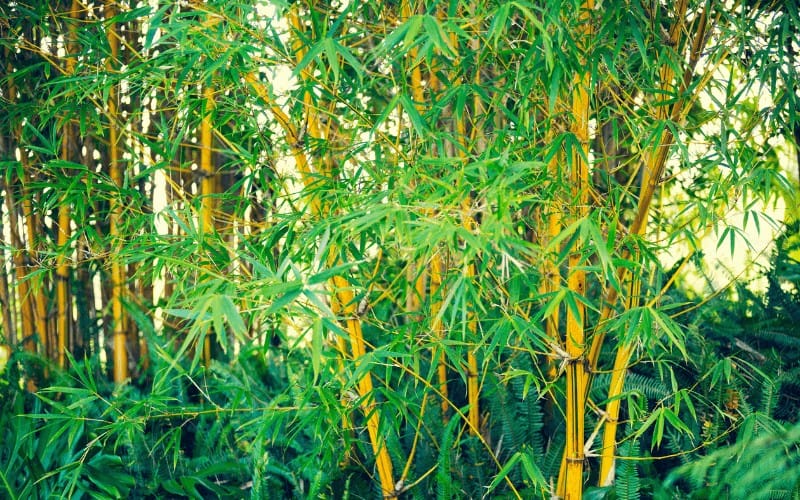Arguably most people would not be interested in growing bamboo because of its demanding nature and uncontrollable growth.
Nonetheless, bamboo is a great evergreen plant. Though considered an outdoor plant, when handled correctly some species will thrive indoors and make its dwelling place super attractive; this means it can be grown indoors and outdoors as well.
Irrespective of this advantage, bamboo might not seem attractive in some circumstances, especially on the verge of dying.
In today’s guide, we’ll help you figure out how to save a dying bamboo plant.
Table of Contents
Bamboo’s Growth and its Varieties
Bamboo grows in well-drained, rich potting soil. Although the plant itself is not attention-seeking, the soil should be kept moist but not over-watered.
The bamboo plant has so many species, this varies from small annuals to giant timbers. Observing the growth pattern of your bamboo plant would help you recognize your plant type, whether it be clumping or running bamboo.
If it grows in dense clumps, then it is clumping bamboo, but if it spreads into the surrounding, it is a running bamboo.
While it would seem impossible to bring most plants back to life, bamboo plants might have a shot at a second chance to live.
Let’s see some dying signs of the bamboo plant.
Signs of a Dying Bamboo Plant

An unhealthy bamboo plant would show you signs before eventually dying. Here are some of those signs:
- Yellow leaves and stems and brown leaves: Depicting loss of strength as a result of insufficient water.
- Slimy roots: This due to loss of nutrients.
- A foul smell
Some factors contribute to these signs. Let’s see some of these contributing factors.
Why Your Bamboo Plant is Dying
Before trying to save your bamboo tree from dying, you need to first understand what's killing it. Here are some of the things that may lead to the death of a bamboo plant:
- Inconsistent temperature: The ideal range of temperature for the bamboo plant is 65 and 85 degrees Fahrenheit. Any exposure outside this range causes its leaves to change color or turn yellow.
- The water source and chlorinated water: Some tap waters could contain chlorine, which will eventually discolor and kill the leaves of the bamboo plant.
- Unclean environment: naturally, plants would not survive in dirty environments as an unkept environment leads to a lot of discomforts.
- Underwatering and overwatering: Failure to water your plant may stunt its growth. On the flip side, over-watering may lead to dampness, foul smell, and infestation from water-loving bacteria such as mold and algae.
- Exposing your bamboo to direct light leaves it susceptible to damage.
- Over-fertilizing your bamboo causes it to lose its natural ability to grow, and eventually kills your plant.
Note: When your plant is over-fertilized, yellowing occurs from the bottom of the plant upward.
How to Save a Dying Bamboo Plant

- Expose your bamboo to a consistent temperature, within the said range to get the desired result, and if indoor, move the bamboo continually from its position to maintain the temperature.
- Avoid using tap water as they contain chloride. Go for distilled water, otherwise, prepare your tap water and allow it to evaporate before use. And, if you use water for growing your bamboo, use bottled water at room temperature.
Furthermore, you can remove the bamboo, rinse it thoroughly and place it in a clean vase of distilled water replace the water every 7days.
- Clean your environment to let your bamboo grow comfortably.
- Do not overwater your plant and if you have been unintentionally doing this due to fear of stunted growth, allow the water to get drained; however, do not let the soil lose its moist.
- When using fertilizer, go for plant-based fertilizers and use it as directed. Replace the soil or flush it with water.
Other Helpful Tips for Better Bamboo Growth
- Sometimes you may find out that after all your efforts, the stem might die eventually. So, experts advise if possible to cut the affected yellow stems to avoid it affecting the others.
- To achieve a healthy look, use sharp, sterile scissors to prune yellow and brown leaves.
- You can regrow your bamboo plant from the healthy tops by cutting them an inch above one of the raised edges.
Recommended Readings:
- How To Get Rid of Grass in Vegetable Garden
- How to Save A Dying Aloe Plant
- How to Save A Dying Jade Plant
- How To Save a Dying Oak Tree
Conclusion
Having known some of the possible reasons why your bamboo plant is dying and their solutions. These guidelines on how to save a dying bamboo plant involve practical steps to follow to raise hopes of resuscitating your bamboo plants.
Hopefully, you get to share your moments reviving your bamboo plants!




